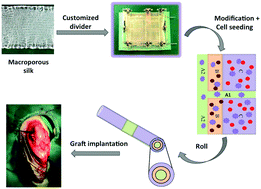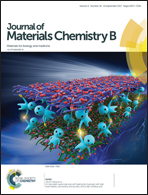Implementation of a stratified approach and gene immobilization to enhance the osseointegration of a silk-based ligament graft†
Abstract
A silk scaffold exhibits high potential for the human anterior cruciate ligament (ACL) reconstruction due to its exceptional mechanics as well as biocompatibility. Inefficient ACL interface restoration is thought to be a major hurdle for the common implementation of a silk-based ligament graft. By integrating a stratified approach and gene immobilization, here we developed a gene-immobilized triphasic silk scaffold to enhance ACL osseointegration. Isotropic silk was divided into three regions (respectively corresponding to a ligament, fibrocartilage and the bone region of the native ACL interface) using a custom-made divider, and the lentiviral vector-encoded transforming growth factor beta-3 (TGF-β3) and bone morphogenetic protein-2 (BMP2) was further, respectively, immobilized to phosphatidylserine (PS)-coated fibrocartilage and the bone region of the triphasic silk scaffold. The in vitro assessments displayed that this gene-immobilized triphasic silk scaffold significantly promotes bone marrow mesenchymal stem cell (BMSC) proliferation and differentiation into corresponding cell lineage. Moreover, the gene-modified triphasic silk scaffold combined with BMSCs alone, which was rolled into a compact shaft to be implanted onto rabbit ACL-defect models, revealed roughly complete osseointegration restoration as a result of apparent three-layered tissue formation and robust mechanical ability as early as 12 weeks postoperatively. These outcomes demonstrated that employing the stratified approach and gene immobilization efficiently expedites silk-mediated ACL interface formation, expanding the therapeutic potential of the silk-based ligament graft for ACL reconstruction.



 Please wait while we load your content...
Please wait while we load your content...